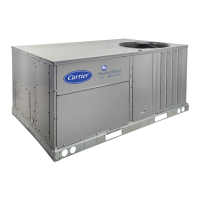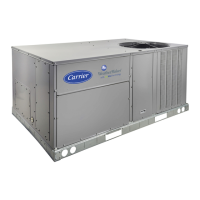45
Economizer Trim Override
The unit may drop stages of cooling when the economizer is per-
forming free cooling and the configuration Configuration
ECON
E.TRM is set to Yes. The economizer controls to the
same supply air setpoint as mechanical cooling does for SumZ
when E.TRM = Yes. This allows for much tighter temperature
control as well as cutting down on the cycling of compressors.
For a long cooling session where the outside-air temperature
may drop over time, there may be a point at which the econo-
mizer has closed down far enough were the unit could remove
a cooling stage and open up the economizer further to make up
the difference.
Mechanical Cooling Lockout (Configuration
COOL
MC.LO)
This configuration allows a configurable outside-air tempera-
ture setpoint below which mechanical cooling will be com-
pletely locked out.
DEMAND LIMIT CONTROL
Demand Limit Control may override the cooling algorithm to
limit or reduce cooling capacity during run time. The term De-
mand Limit Control refers to the restriction of machine capaci-
ty to control the amount of power that a machine will use. This
can save the owner money by limiting peaks in the power sup-
ply. Demand limit control is intended to interface with an ex-
ternal Loadshed Device either through CCN communications,
external switches, or 4 to 20 mA input.
The control has the capability of loadshedding and limiting in 3
ways:
• Two discrete inputs tied to configurable demand limit set-
point percentages.
• An external 4 to 20 mA input that can reset capacity back
linearly to a setpoint percentage.
• CCN loadshed functionality.
NOTE: It is also possible to force the demand limit variable (Run
Status
COOL
DEM.L).
To use Demand Limiting, select the type of demand limiting to
use. This is done with the Demand Limit Select configuration
(Configuration
DMD.L
DM.L.S).
To view the current demand limiting currently in effect, look at
Run Status
COOL
DEM.L.
The configurations associated with demand limiting can be
viewed at the local display at Configuration
DMD.L. See
Table 48.
Demand Limit Select (DM.L.S)
This configuration determines the type of demand limiting.
• 0 = NONE — Demand Limiting not configured.
• 1 = 2 SWITCHES — This will enable switch input de-
mand limiting using the switch inputs connected to the
CEM board. Connections should be made to TB6-4, 5, 6.
• 2 = 4 to 20 mA — This will enable the use of a remote 4 to
20 mA demand limit signal. The CEM module must be
used. The 4 to 20 mA signal must come from an externally
sourced controller and should be connected to TB6-7, 8.
• 3 = CCN LOADSHED — This will allow for loadshed and
red lining through CCN communications.
Two-Switch Demand Limiting (DM.L.S = 1) — This type of
demand limiting utilizes two discrete inputs:
Demand Limit Switch 1 Setpoint (D.L.S1) — Dmd Limit
Switch Setpoint 1 (0 to 100% total capacity)
Demand Limit 2 Setpoint (D.L.S2) — Dmd Limit Switch Set-
point 2 (0 to 100% total capacity)
The state of the discrete switch inputs can be found at the local
display:
Inputs
GEN.I
DL.S1
Inputs
GEN.I
DL.S2
The following table illustrates the demand limiting (Run Sta-
tus
COOL
DEM.L) that will be in effect based on the log-
ic of the applied switches:
4-20 mA Demand Limiting (DM.L.S = 2) — If the unit has
been configured for 4 to 20 mA demand limiting, then the In-
puts
4-20
DML.M value is used to determine the amount
of demand limiting in effect (Run Status
COOL
DEM.L). The Demand Limit at 20 mA (D.L.20) configuration
must be set. This is the configured demand limit corresponding
to a 20 mA input (0 to 100%).
The value of percentage reset is determined by a linear interpo-
lation from 0% to “D.L.20”% based on the Inputs
4-20
DML.M input value.
The following examples illustrate the demand limiting (Run
Status
COOL
DEM.L) that will be in effect based on
amount of current seen at the 4 to 20 mA input, DML.M.
CCN Loadshed Demand Limiting (DM.L.S = 3) — If the unit
has been configured for CCN Loadshed Demand Limiting,
then the demand limiting variable (Run Status
COOL
DEM.L) is controlled via CCN commands.
The relevant configurations for this type of demand limiting are:
Loadshed Group Number (SH.NM) — CCN Loadshed Group
number
Loadshed Demand Delta (SH.DL) — CCN Loadshed Demand
Delta
Maximum Loadshed Time (SH.TM) — CCN Maximum Load-
shed time
Table 48 — Demand Limit Configuration
Switch Status Run Status
COOL
DEM.L = 1
Inputs
GEN.I
DL.S1 = OFF
Inputs
GEN.I
DL.S2 = OFF
100%
Inputs
GEN.I
DL.S1= ON
Inputs
GEN.I
DL.S2 = OFF
Configuration
DMD.L
D.L.S1
Inputs
GEN.I
DL.S1= ON
Inputs
GEN.I
DL.S2 = ON
Configuration
DMD.L
D.L.S2
Inputs
GEN.I
DL.S1= OFF
Inputs
GEN.I
DL.S2 = ON
Configuration
DMD.L
D.L.S2
D.L.20 = 80% D.L.20 = 80% D.L.20 = 80%
DML.M = 4mA DML.M = 12 mA DML.M = 20mA
DEM.L = 100% DEM.L = 90% DEM.L = 80%
ITEM EXPANSION RANGE UNITS CCN POINT DEFAULT
DMD.L DEMAND LIMIT CONFIG.
DM.L.S Demand Limit Select 0 to 3 DMD_CTRL 0
D.L.20 Demand Limit at 20 ma 0 to 100 % DMT20MA 100
SH.NM Loadshed Group Number 0 to 99 SHED_NUM 0
SH.DL Loadshed Demand Delta 0 to 60 % SHED_DEL 0
SH.TM Maximum Loadshed Time 0 to 120 min SHED_TIM 60
D.L.S1 Demand Limit Sw.1 Setpt. 0 to 100 % DLSWSP1 80
D.L.S2 Demand Limit Sw.2 Setpt. 0 to 100 % DLSWSP2 50

